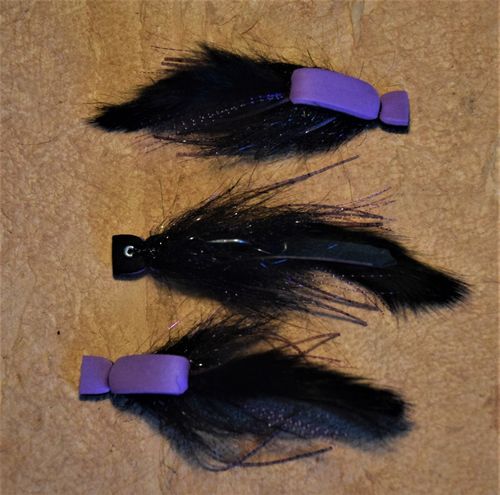
Gurgler Fly

The original Gurgler pattern was developed by angling legend Jack Gartside. This simple top water pattern is not really a “popper” or a “slider” and has a unique action that “gurgles” and sputters along the surface, drawing the attention and strikes from a variety of game fish including bass, northern pike, and snook just to name a few. This variation of Jack’s famous fly is designed to be eaten by Baby Tarpon.
Designed with a slim profile it casts relatively easily, and the rubber legs and rabbit strip provide plenty of motion. Combine this enticing action with the sparkle of EP streamer brush and this pattern really attracts a tarpon’s attention. Used to catch baby Silver Kings wherever they live, this fly has proven particularly productive in the Campeche, Mexico area. To quote Alejandro from Campeche Tarpon, “the gurgler is king.”
Effective color variations of this fly include white/red and yellow/chartreuse.
Hook: Daiichi 2546, Size 1/0
Thread: Black 6/0 UNI-Thread
Foul guard: 30lb Mason hard mono
Tail: Black magnum rabbit strip (zonker)
Flash: Purple krystal flash
Legs: Dark dun Loco Legs
Shell: 2mm black foam and adhesive backed 2mm purple foam
Body: Peacock black Ice Dub
Synthetic Hackle: Black EP anadromus brush
Cement: Hard as Hull
Tying Instructions
Step 1.
Insert the hook in the vise, attach the thread and wrap back to the hook bend building up a thread base.
Step 2.
Tie in a black magnum rabbit strip (approximately 2 inches in length) extending off the back of the hook.
Step 3.
Tie in a 30lb mono loop on top of the rabbit strip tie-in point. This loop should extend a hook gap length from the bend in the hook. Pull the rabbit strip up through the loop so that the strip sits on top of the mono loop. This will help to prevent the rabbit strip from fouling around the hook.
Step 4.
Tie in 6 strands of purple krystal flash so that they extend down each side of the rabbit strip. Trim them slightly longer than the tail.
Step 5.Fold a single Loco leg over the thread and tie it in so that half extends down one side of the tail and half down the other side. Leave the legs long for added motion. Coat the tie in point with Hard as Hull for added durability.
Step 6.
Prepare a strip of double layer closed-cell foam, purple over black, by cutting two pieces of foam in roughly equal widths (slightly narrower than the hook gap; ½ inch wide) and sticking them together. These pieces should be of sufficient length to form both the shell and lip of the fly. Trim what will be the rear portion of the foam shell into a tapered point.
Step 7.
Prepare a second foam strip of 2mm black foam for the body. Cut the foam slightly narrower than the hook gap (½ inch wide) with a tapered point at one end. The overall length should be ¾ of an inch.
Step 8.
At the hook bend tie-in point secure the tapered point of the black/purple foam shell with several thread wraps.
Step 9.
Advance the thread to a point two hook widths behind the eye.
Step 10.
Fold one end of the black foam strip around the hook shank and make a single turn of thread over the foam. Don’t tighten it until you come all the way around with the thread and pull straight down. Hold the foam in place on the top of the hook as you do this first wrap and then follow up with several additional wraps stacked on to of the first to lock the foam in place.
Step 11.
Spiral wrap the thread back over the foam to the hook bend, anchoring it with several additional wraps of thread at this end point.
Step 12.
Tie in a length of EP anadromus brush at the bend.
Step 13.
Twist some Ice Dub onto the thread and wrap forward and back covering the foam and forming a scruffy body. Stop your last wrap of the dubbed thread at the point one third of the body length forward of the hook bend.
Step 14.
Palmer the EP anadromus brush forward two turns and tie off (do not cut the streamer brush).
Step 15.
Fold another single Loco leg over the thread and tie it in so that half extends down one side of the body and half down the other side. Twist the thread with more dubbing and wrap forward two thirds of the body length.
Step 16.
Continue to palmer the EP anadromus brush forward another two turns and tie off (again, do not cut the streamer brush).
Step 17.
Add a final pair of Loco legs by folding a single rubber leg over the thread and tying it in so that half extends down one side of the body and half down the other side.
Step 18.
Advance the thread, twisted with more dubbing, to a point two hook eye widths behind the eye.
Step 19.
Palmer the EP anadromus brush forward another two turns, tie off and cut with a pair of side cutters.
Step 20.
Part and brush the EP anadromus brush fibers that are on top of the hook shank to the sides of the fly.
Step 21.
Pull the black/purple foam shell over the body and secure with six firm thread wraps.
Step 22.
Wrap the thread in front of the foam “lip” that extends over the eye and build up a small thread head.
Step 23.
Whip finish and cement the thread wraps.
Step 24.
Trim the foam “lip” so it extends approximately 1/4 inch over the hook eye. The length and shape of this lip determines the action of the fly when stripped so feel free to experiment.



